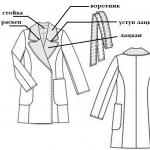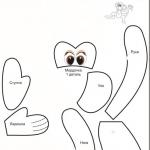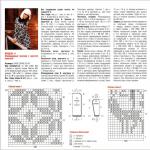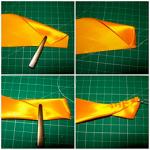Handwriting correction: useful tips for parents of schoolchildren. How to make your child have beautiful handwriting Words starting with the letter w to improve handwriting
Natalya Kalichenok, deputy director for academic work in primary grades at the State Educational Institution “Gymnasium No. 4 in Vitebsk,” helped understand the relationship between handwriting and performance in school subjects.
– Does poor handwriting affect a student’s academic performance?
– The answer to this question cannot be unambiguous. While forcing a child to write beautifully, we forget that calligraphy is a special type of fine art. Not everyone is blessed with perfect handwriting. But first you need to understand what actually bothers you - just ugly written words or numerous blots, mistakes, mixed up letters?
On the one hand, if you worry solely about beauty, then the trouble is not so great. The most important thing is that the words are readable and there are no grammatical errors in the text. On the other hand, ugly handwriting can actually cause many children to fail academically. In elementary school, grades are reduced depending on the number of corrections in accordance with certification standards. Then the motivation to study disappears because the handwriting cannot be changed.
In addition, a child who writes ugly and sloppy often does it slower than others because his hand gets tired faster. As a result, he does not have time to write everything on the tests and gets bad grades. As a result, even the smartest child can turn into a poor student.
– Is it possible to correct handwriting, for example, in adolescence? If yes, what should you do about it?
– Bad handwriting needs to be corrected, and this requires regular practice. The sooner you start improving it, the better the process will go. A younger student can be taught new things faster, and he will be more willing to correct his mistakes. Correcting handwriting will help the child to be more diligent and attentive, and these qualities will be useful in future school life. But first of all, it is important to identify the cause of poor handwriting.
Reason #1. Incorrect body position, arms, posture, leg position, unsuitable writing pens. The success of writing is largely determined by the creation of optimal hygienic conditions: selection of furniture, seating, lighting direction, optimal handle shape, duration of continuous writing, etc.
Reason #2. Incorrect position of the notebook on the desk.
Reason #3. Fine motor skills of the hands are poorly developed.
Reason #4. Insufficient level of development of spatial perception. Usually this problem is not too serious and goes away quickly. Very often, parents, seeing that the child is confusing the letters or that they are “hovering in the air,” force him to redo the same thing a hundred times! But repeated rewriting will not help here.
Reason #5. Features of brain organization. Many people believe that disgusting handwriting is just a consequence of inattention, lack of concentration and laziness. But that's not true. The most important organ responsible for writing is not the hand, but the head. In order to learn to write, it is necessary not only the relationship between thinking and fine motor skills of the hand, but also the ability to translate the information contained in the brain into a system of signs.
Therefore, problems associated with mastering written language may signal disorders of the brain. Most often, these are not serious pathologies, but some individual characteristics of the child. For example, left-handers (especially overtrained ones), as well as people who are equally good with both hands, may experience difficulties. However, all this is usually easily overcome.
There is a much more serious problem - dysgraphia, which can be accompanied by dyslexia - difficulties in perceiving printed text. The cause of dysgraphia and dyslexia is a disruption of the neural connections that transmit information between the hemispheres of the brain. The handwriting of a dysgraphic person is not just horror, but horror-horror! Crooked lines and clumsy letters are not so bad.
Words may be written in a mirror image, letters may be mixed up or missing, the distance between words may be uneven, and there will be a large number of errors, blots and corrections. But at the same time, dyslexics and dysgraphics are often much smarter than other children.
Many experts believe that if people who successfully combine the work of both hemispheres of the brain have two-dimensional vision, then the perception of dyslexics and dysgraphics is three-dimensional. But, having this unique quality, in most cases they do not know how to use it. In general, either geniuses grow out of them (for example, Albert Einstein, Hans Christian Andersen were dysgraphic), or people who are not confident in their own abilities.
Dysgraphia is a serious problem that interferes with normal learning and is directly related to the functioning of the brain. Therefore, attentive parents and teachers need to promptly show the child and his notebook to specialists - a speech therapist, a psychologist.
– Are there any techniques or exercises to improve handwriting?
There are a lot of tools and methods that can help improve a child’s handwriting. Various drawing techniques, shading, drawing a figure by dots, sculpting, playing with small details (construction set, weaving, knitting), etc.
Writing with a ballpoint pen involves constant muscle tension, so make it a rule to buy one with your child. Make sure the pen does not scratch, snag or scrape the paper. It is more convenient to practice at home with a pencil, felt-tip pen, or gel pen. It is quite possible to introduce students in grades 5 to 7 to such a representative of the retro style as a fountain pen.
If your child incorrectly connects and writes certain elements, you should pay attention to practicing them. Use tracing paper. Place the tracing paper on top of the page. The child needs to circle the sample, write it two more times, and then remove the tracing paper and let him copy everything into a clean copy. This way, the hand gets used to writing beautiful letters, and your student doesn’t get too tired.
You can also use a “zebra” - a lined sheet of paper (with slanted lines located at equal intervals from each other), which children place under the notebook page and write letters along the lines: this will help maintain the same size and slant, and improve calligraphy.
The time you allocate to work on improving handwriting and the number of training exercises should be measured. Don't overload your daughter or son. You should not expect positive results from your child if every evening, instead of walking and communicating, you force him to rewrite various texts over and over again for hours. When checking your work, try to pay attention not to what did not work out, but on the contrary - how the child wrote certain words or even letter combinations correctly and beautifully.
At an older age, frequent rewriting of texts at a slow pace will help correct the situation, the volume of which must be increased as incorrect or simply ugly written letters are corrected. To rewrite, choose the works of your favorite prose authors.
Boring workouts will turn into an exciting activity if you start keeping a diary or constantly writing down interesting thoughts, not forgetting about beautiful handwriting.
Alesya Grishman.
Each person is unique and unique in everything - appearance, timbre of voice, habits, eye color, fingerprints. This also includes handwriting.
There are people who are not happy with their handwriting - they don’t like it, they are even embarrassed by it. And there are those whose handwriting is so illegible that sometimes this causes big problems in life. This category of people includes doctors. And don't say you didn't try to read what the doctor wrote in your medical record.
 However, do not be upset, because everything can be improved if there is a desire.
However, do not be upset, because everything can be improved if there is a desire.
Where should you start on the path to improving your handwriting?
 First of all, you need to set yourself up for success. Be positive. Buy yourself a beautiful and comfortable pen, make sure that the notebook in which you will practice is pleasing to your eye. Training to improve handwriting should be done with pleasure and joy.
First of all, you need to set yourself up for success. Be positive. Buy yourself a beautiful and comfortable pen, make sure that the notebook in which you will practice is pleasing to your eye. Training to improve handwriting should be done with pleasure and joy.
 It is recommended to have before your eyes a good example of handwriting that in your opinion is considered ideal. Alternatively, computer fonts and manuscripts from your friends and relatives can be used.
It is recommended to have before your eyes a good example of handwriting that in your opinion is considered ideal. Alternatively, computer fonts and manuscripts from your friends and relatives can be used.
You need to start training by writing individual elements. Remember your first grade, when you wrote one squiggle more than one line in a notebook? It's time to remember this carefree time! To write the elements of letters and the letters themselves, you can also use school copybooks, which today can be easily purchased at any stationery store.

Be sure to hold the pen correctly!
 If not all letters in your spelling suffer, it is recommended to pay special attention to the elements that are difficult for you. Remember! You won’t be able to improve your handwriting in one evening, so set yourself up for long-term work, which will definitely bring you pleasant results.
If not all letters in your spelling suffer, it is recommended to pay special attention to the elements that are difficult for you. Remember! You won’t be able to improve your handwriting in one evening, so set yourself up for long-term work, which will definitely bring you pleasant results.
After you have devoted some time to writing the elements of letters, you should move on to a more complex activity - writing words and entire sentences. Don't be lazy and try to write the same word as many times as possible. Do the same with whole sentences! With this you can hone not only the writing of letter elements, but also their connections with each other.
Write slowly, measuredly and carefully.
Usually people improve their handwriting when they no longer need to attend training classes. Students' beautiful handwriting is evident only when drawing up explanatory notes for the dean's office. If a person wants, he begins to write beautifully and clearly. The need to correct handwriting may arise among people holding high-ranking positions or teachers at school (especially Russian language and literature).
Is it possible to correct handwriting as an adult, how to do it?
Of course, if there is a need for this, do not be lazy and use the proposed guidance, then this is possible. To get beautiful handwriting you need:
Notebooks;
Computer;
Workplace;
Internet;
Collection of poems.
You should start by preparing the workplace. To develop beautiful handwriting you will need daily practice. It is easier to practice spelling in a comfortable position.
To make a beautiful recording, you should position your body correctly. Under no circumstances should it be tense. You need to choose a chair that will keep your back straight. Place your feet on the floor, not in a hanging position.
Proper lighting is equally important. It is better to sit near a natural light source.
It may seem that all these demands are placed on children when they are taught to write, but how can you correct the handwriting of an adult who has already gone through all this once? There is no need to immediately despair and give up on this idea, because you have to plunge a little into childhood.
How to fix bad handwriting?
You should ensure that you have the following consumables: ballpoint and fountain pens. The notebook should be like that of first-graders, with a slanted ruler. This is necessary to develop an inclination. Then the training will move on to unlined A4 sheets. It is recommended to use poems written by classical poets. This will help you not only learn to write beautifully, but also improve your language.
Do you take care of your handwriting? Writing beautifully is not an outdated skill in our computer age, but a way to express respect for yourself and for those who will read your writing. How to learn to write in beautiful handwriting, read our article today.
Why write in beautiful handwriting?
It would seem that every year we make fewer and fewer notes with a pen and type more and more text on a computer keyboard, and personal notes in a notebook will not make it into the exhibition of the most beautiful handwriting in the world, so many do not make an effort to correct flaws and ennoble their own writing .
However, you need smooth, legible, and aesthetic handwriting for many reasons:
- eliminates errors and helps to correctly understand the text;
- does not cause irritation to the reader;
- disciplines thought while writing;
- useful for greeting cards and gift inscriptions;
- ensures always the same and beautiful personal signature;
- speaks for your character.
The last point is connected not only with the subconscious reaction of the reader to your notes - it is quite natural that even lines evoke respect and sympathy for their author. A separate science, graphology, deals with the analysis of the characteristics of personal writing.
All our curls and squiggles, as well as the inclination of letters, lines and even the pressure of a pen can tell us about our character qualities no less than our appearance. Knowing about these patterns, it’s probably worth paying a little more attention to how we write - after all, this is part of our individual style, which others will definitely pay attention to.
Who has the most beautiful handwriting?
Without hesitation, you can answer who it is disgusting and causes the most criticism - these are, of course, medical employees, whose entries in the cards cause bewilderment not only among patients, but also among fellow doctors.
But there are also specialties where legible, exemplary writing is a professional requirement. These include school teachers, archive workers and librarians, as well as representatives of the rare specialty of calligrapher at any time.
If we ignore professions, we can safely say that beautiful handwriting is possessed by calm, balanced people, those who are in no hurry to take notes, who have good hand control (fine motor skills) and, most importantly, who consciously strive to write legibly and evenly.
Thus, the skill of writing is subject to volitional efforts and depends on training. You can learn this at any age using certain techniques.
Calligraphy - the art of beautiful writing

In the world today there are 15 schools, or directions, of calligraphy, each of which has made a real masterpiece out of writing based on the national alphabet (Persian script, Chinese calligraphy, etc.).
Cyrillic calligraphy has an ancient tradition, and its principles are still used in teaching children in primary school.
Simplified Cyrillic calligraphy is a copybook familiar to us from childhood, by which schoolchildren learn to write, and adults, if desired, can significantly improve the quality of their writing.
Training the hand: basic exercises
How to make your handwriting beautiful if you are no longer a student? Is it really too late to relearn, and will your squiggles forever remain a problem? This is not at all necessary if you set out to correct the situation. And you need to start by positioning your hand. To do this, before class, do a little gymnastics: circular movements, clenching your fists, stretching your wrist, flexing and extending your fingers.
Let's get started with pen and paper:
- draw large examples of copybook shapes - spirals, zigzags, repeating lowercase letter Ш, letter A, G;
- slowly, while controlling your movements, draw samples along the contour;
- concentrate on the sensations in your fingers and hand when moving the handle;
- repeat the figures until you achieve the effect of automatism;
- Having mastered the figure, try to draw it faster;
- Having mastered the quick drawing of a figure, continue drawing it, but smaller.
You need to study in peace and quiet, in good lighting, on thick paper with a good pen. For daily exercise, allocate 15-20 minutes, or train for 30-40 minutes every other day.
Beautiful handwriting starts with the alphabet. To write in beautiful handwriting, use the calligraphic Cyrillic alphabet. You can purchase one from an office supply store or make your own using a template from the Internet.
Your initial goal is to learn how to write individual letters (uppercase and lowercase) in perfect patterns, then move on to letter combinations connected by smooth lines.
How to develop beautiful handwriting
The secret to success is frequent practice, which means you will have to write by hand more than usual. When rewriting the training text, do not rush, but also do not “hang” on each letter.
Follow the details:
- all letters must be the same size;
- write, evenly spacing letters and words, while maintaining the slope;
- use an oblique ruler only the first time; at the end of training, switch to unlined paper;
- the edges of the letters should not break up or slide down the lines;
- use equal spaces between words;
- Pay attention to punctuation marks - display them the same, clear, and legible.
Calligraphy for left-handers
Despite the fact that, according to the rules of calligraphy, the writing instrument is held in the right hand, congenital left-handers usually have more elegant handwriting. Retraining changes the situation somewhat, and often children who were easily able to write school copybooks with their left hand become the owners of illegible and sloppy handwriting with their right hand.
The peculiarity of using the left hand is that the calligraphic tilt to the right is physically difficult for left-handed people to maintain. Therefore, the natural way out, which they find themselves, is a change in tilt to the left, often very noticeable.

This option is not considered a classic, but with it you can achieve greater legibility, master the continuous writing of long words and maintain a straight line. In this case, it is unacceptable to unfold the sheet of paper, creating an artificial slope of the line
Why might you need beautiful handwriting? Maybe at work you need to write beautifully and legibly. Well, for example, writing letters for business executives. Or sign greeting cards for various holidays. Engineers may also need beautiful, neat handwriting to fill out drawings and technical documentation. In this case, the filling rules themselves require the use of a specific font. There can be many reasons, including a simple aesthetic desire to write beautifully and not scribble in any situation.
To the question of how to develop beautiful handwriting, the answer is clear: you need to work on improving it. Painstakingly, diligently, for a long time. First of all, you need to write and write, and practice a lot. At the same time, not chaotically, but according to certain examples. You will need a thick notebook and a pen with spare refills. It is best to take the notebook into the cage. This will help you write smoothly and in the same letters. It is also advisable to get examples of different fonts for clarity.
You need to start by writing each letter separately, several times. One letter must fit in one cell. You can try different fonts. After trying different fonts, you can choose the one you like best or which will work better. After practicing with individual letters, you should take any book, fiction or scientific, and start rewriting the text from it in a new handwriting. If there are professional texts to write down, that’s even better. In this case, you will be training your handwriting and doing your work at the same time. You should try to write evenly, square to square, carefully connecting the letters together.
At first it can be a little difficult: the hand and fingers may get tired, the letters may not turn out as desired, the text will float along the lines. We need to try, keep working. This is how you can correct ugly handwriting and develop a new one.
A good option for developing beautiful handwriting can be using a drawing font. After adaptation to a specific hand, such handwriting becomes neat and beautiful. To do this, you need to take some kind of drawing; in the header of the drawing there are signatures and various text notes. First, individual letters are trained, and then words and sentences. In a drawing font, the letters are usually not connected to each other. But in handwritten text they need to be combined. Therefore, you will get an original version of the handwriting, but at the same time the beauty of the letters and the accuracy of the writing will be preserved.
If it is not an adult who needs to develop beautiful handwriting, but a child, then everything is a little simpler. Essentially the same thing happens. The child learns to write letters, then connects letters into syllables, syllables into words, and so on. Parents or educators need to ensure that the child tries to write smoothly and correctly. There should be no shirking or negligence. Because the foundations are being laid now. Further, the handwriting will remain the same as it was developed from the very beginning. After all, changing your handwriting will be more difficult than making it beautiful in the first place. Developing beautiful handwriting is not technically difficult. All you need is samples and persistent practice.






